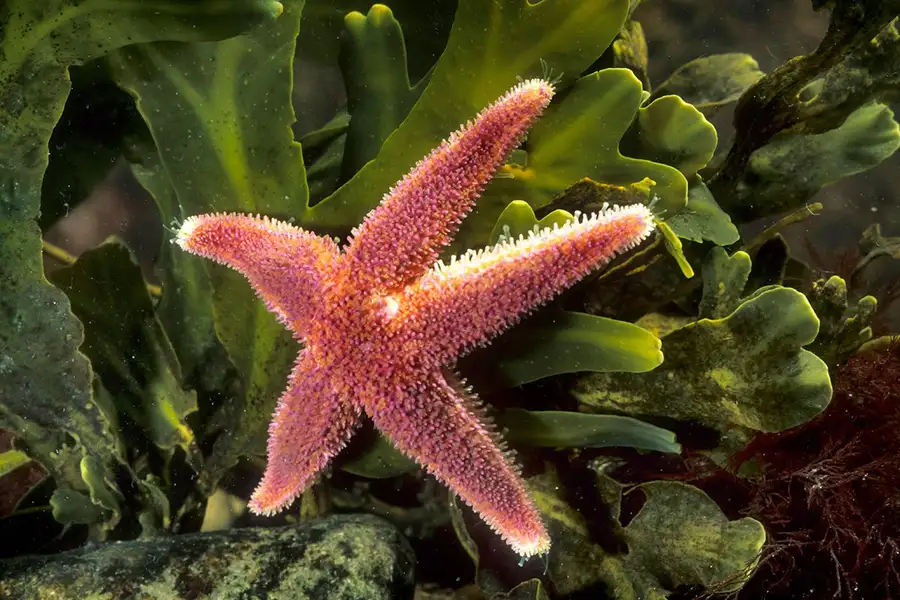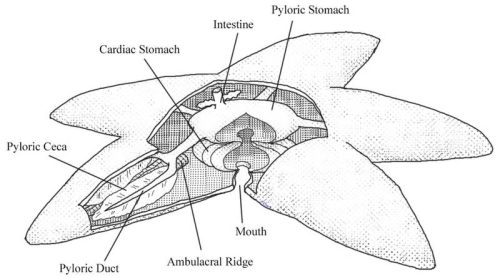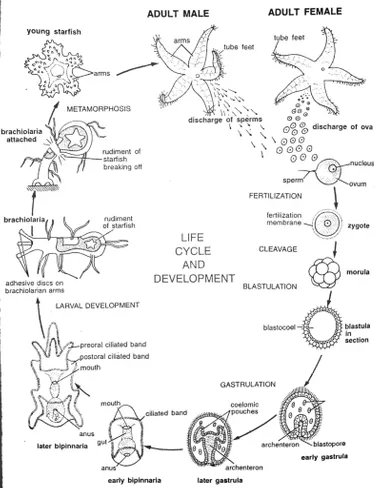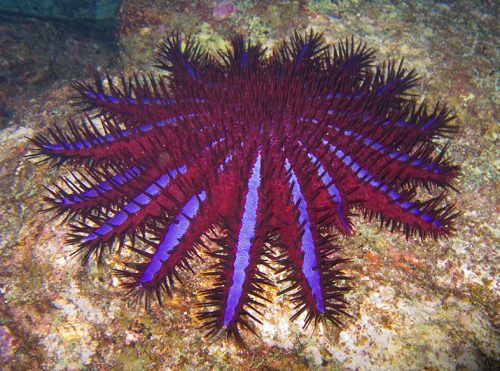STARFISH

Photo Credit : blickwinkel/Alamy
Starfish, also known as sea stars, are named for their distinctive star-shaped morphology. They typically have five symmetrical arms, though some species can have up to 40 arms. These invertebrate marine animals are known for their natural beauty and vibrant colors. Taxonomically, starfish belong to the class Asteroidea within the phylum Echinodermata. They are divided into seven different orders: Brisingida, Forcipulatida, Paxillosida, Notomyotida, Spinulosida, Valvatida, and Velatida.
Starfish have a fully developed digestive system and internal body cavities. Food, consisting of organic matter and plankton, enters through the mouth, travels down the esophagus, and reaches the stomach. The stomach then branches off into each of the starfish's arms. The remaining undigested material is expelled through the anus, which is located on the aboral (dorsal) surface of the starfish's body.

Starfish digestive system (Photo Credit : Tassledown)
The distribution of starfish species spans across a wide geographic range, including the southern Indian Ocean, the Mascarene Islands, eastern Africa (including Madagascar), the Maldives, the Bay of Bengal, eastern India, northern Australia, the Philippines, China, Japan, the southern Pacific, and Hawaii.
Starfish have two main reproductive strategies, asexual and sexual reproduction. Asexual reproduction occurs through a process of regeneration, where if a starfish loses a body part, it can grow that part back and form a new individual. Some species can even divide in half, with each half developing into a complete starfish.

Starfish asexual reproduction (Photo Credit : graphicsrf)
For sexual reproduction, male starfish release sperm into the water, which is then taken in by female starfish that release eggs. Fertilization happens inside the female's body, and the fertilized eggs develop into larval forms.

Starfish sexual reproduction (Photo Credit : Ferris Jabr)
Starfish remarkable regenerative abilities and efficient reproductive strategies allow their populations to thrive and multiply rapidly in suitable marine environments.
Starfish play two key roles in marine ecosystems. First, they act as detritivores, feeding on decaying organic matter. Second, they are predators that prey on smaller organisms like mollusks, clams, and crustaceans. Some starfish species can form complex habitat structures with their interconnected body tissues, providing shelter for other marine life such as fish, crustaceans, and small mollusks.
By preventing overpopulation and maintaining balance, starfish help keep coral reef ecosystems healthy. However, the voracious, coral-eating crown-of-thorns starfish (Acanthaster planci) poses a serious threat to coral reefs, especially as it can tolerate rising ocean temperatures. Efforts have been made to actively destroy these destructive starfish in places like Indonesia and the Great Barrier Reef, often by capturing them and injecting natural acids to kill them.

Acanthaster planci (Photo Credit : Jon hanson)
Starfish themselves are also an important food source for various marine predators, including fish, seabirds, and octopuses. Additionally, certain starfish species are used in pharmacology, for example the starfish is used to treat gout and asthma.
-YN

